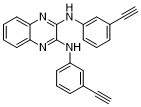PD: TD52, an Erlotinib derivative, is an orally active, potent cancerous inhibitor of protein phosphatase 2A (CIP2A) inhibitor. The CIP2A/PP2A/p-Akt signaling pathway is regulated by TD52, which also mediates the apoptotic effect in triple-negative breast cancer (TNBC) cells. As Elk1's binding to the CIP2A promoter was disrupted, TD52 indirectly decreased CIP2A. In spite of its strong anti-cancer activity, TD52 has less p-EGFR inhibition.
Physicochemical Properties
| Molecular Formula | C24H16N4 |
| Molecular Weight | 360.41064453125 |
| Exact Mass | 360.137 |
| Elemental Analysis | C, 79.98; H, 4.47; N, 15.55 |
| CAS # | 1798328-24-1 |
| Related CAS # | TD52 dihydrochloride |
| PubChem CID | 118656842 |
| Appearance | White to yellow solid |
| LogP | 5.5 |
| Hydrogen Bond Donor Count | 2 |
| Hydrogen Bond Acceptor Count | 4 |
| Rotatable Bond Count | 6 |
| Heavy Atom Count | 28 |
| Complexity | 559 |
| Defined Atom Stereocenter Count | 0 |
| InChi Key | SCUPZFSEJFWQIS-UHFFFAOYSA-N |
| InChi Code | InChI=1S/C24H16N4/c1-3-17-9-7-11-19(15-17)25-23-24(26-20-12-8-10-18(4-2)16-20)28-22-14-6-5-13-21(22)27-23/h1-2,5-16H,(H,25,27)(H,26,28) |
| Chemical Name | 2-N,3-N-bis(3-ethynylphenyl)quinoxaline-2,3-diamine |
| Synonyms | TD52; TD 52; TD-52; erlotinib analogue; erlotinib derivative |
| HS Tariff Code | 2934.99.9001 |
| Storage |
Powder-20°C 3 years 4°C 2 years In solvent -80°C 6 months -20°C 1 month |
| Shipping Condition | Room temperature (This product is stable at ambient temperature for a few days during ordinary shipping and time spent in Customs) |
Biological Activity
| ln Vitro |
TD52 (2-10 μM; 48 hours) exhibits an anti-proliferative effect and causes varying levels of apoptosis in these cell lines[1]. TD52 (5 μM; 48 hours) has minimal effects on p-EGFR or EGFR expression but downregulated CIP2A expression[1]. TD52 (2.5, 5, 7.5 μM; 48 hours) time-dependently induces apoptosis while also downregulating CIP2A and p-Akt[1]. TD52 (5 μM; 24 hours)significantly boosts PP2A's phosphatase activity in TNBC cells[1]. TD52 (5 μM; 48 hours) has no obvious effects on other common RTKs, such as IGFR, PDGFR and VEGFR2[1]. |
| ln Vivo | TD52 (10 mg/kg/day; oral gavage; for 52 days) significantly reduces MDA-MB-468 xenograft tumor size and tumor weight[1]. |
| References |
[1]. EGFR-independent Elk1/CIP2A signalling mediates apoptotic effect of an erlotinib derivative TD52 in triple-negative breast cancer cells. Eur J Cancer. 2017 Feb;72:112-123. |
Solubility Data
| Solubility (In Vitro) | DMSO: ~100 mg/mL (~277.5 mM) |
| Solubility (In Vivo) |
Solubility in Formulation 1: 2.5 mg/mL (6.94 mM) in 10% DMSO + 40% PEG300 + 5% Tween80 + 45% Saline (add these co-solvents sequentially from left to right, and one by one), suspension solution; with sonication. For example, if 1 mL of working solution is to be prepared, you can add 100 μL of 25.0 mg/mL clear DMSO stock solution to 400 μL PEG300 and mix evenly; then add 50 μL Tween-80 to the above solution and mix evenly; then add 450 μL normal saline to adjust the volume to 1 mL. Preparation of saline: Dissolve 0.9 g of sodium chloride in 100 mL ddH₂ O to obtain a clear solution. Solubility in Formulation 2: 2.5 mg/mL (6.94 mM) in 10% DMSO + 90% (20% SBE-β-CD in Saline) (add these co-solvents sequentially from left to right, and one by one), suspension solution; with ultrasonication. For example, if 1 mL of working solution is to be prepared, you can add 100 μL of 25.0 mg/mL clear DMSO stock solution to 900 μL of 20% SBE-β-CD physiological saline solution and mix evenly. Preparation of 20% SBE-β-CD in Saline (4°C,1 week): Dissolve 2 g SBE-β-CD in 10 mL saline to obtain a clear solution. (Please use freshly prepared in vivo formulations for optimal results.) |
| Preparing Stock Solutions | 1 mg | 5 mg | 10 mg | |
| 1 mM | 2.7746 mL | 13.8731 mL | 27.7462 mL | |
| 5 mM | 0.5549 mL | 2.7746 mL | 5.5492 mL | |
| 10 mM | 0.2775 mL | 1.3873 mL | 2.7746 mL |
